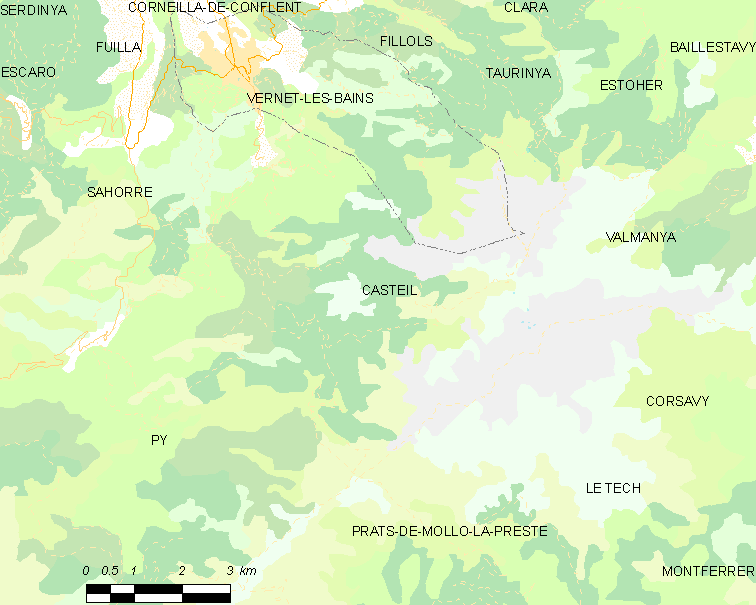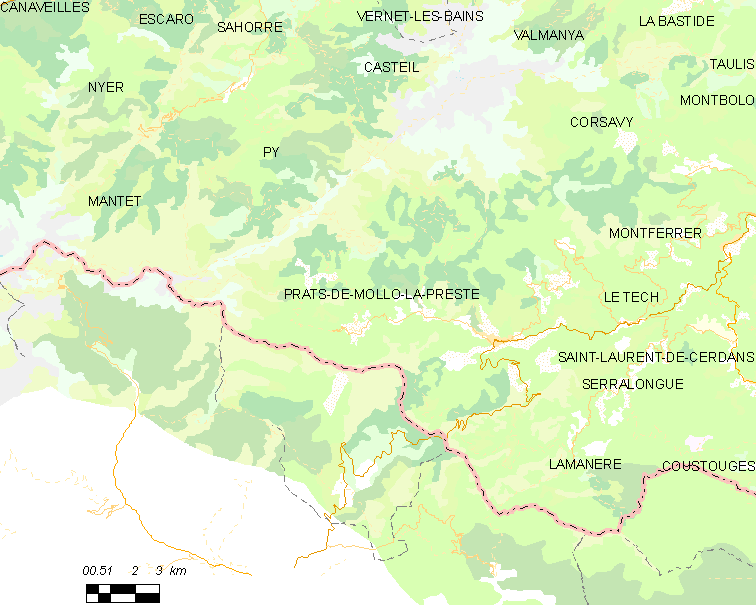|
Canigó
The Canigó ( , ; ; ) is a mountain located in the Pyrenees of southern France. The Canigó is located less than from the sea and has an elevation of . Due to its sharp flanks and its dramatic location near the coast, until the 18th century the Canigó was believed to be the highest mountain in the Pyrenees. Being between south and Northern Catalonia, the mountain has a historical symbolical significance for Catalan people. In good weather, it is visible from Marseille on 8 February and 31 October, due to atmospheric optical effects. Geography The Canigó is located in Pyrénées-Orientales, south of Prades, Pyrénées-Orientales, Prades and north of Prats-de-Mollo-la-Preste. Its summit lies on the border between two communes: Vernet-les-Bains and Taurinya (although the territories of two other communes - Casteil and Valmanya - approach quite closely to the summit). Its location makes it visible from the plains of Roussillon and from Conflent in France, and as well from Em ... [...More Info...] [...Related Items...] OR: [Wikipedia] [Google] [Baidu] |
Vernet-les-Bains
Vernet-les-Bains (; ) is a commune in the Pyrénées-Orientales department in southern France. The Catalan word for an alder tree is "vern". "Vernet" is derived from "verneda", a Catalan word meaning a group of alder trees. "Vernet" officially became "Vernet-les-Bains" in 1953. It is a centre for visitors and holidaymakers. The village has a sunny climate (with, on average, 300 days of sunshine each year) and is set in a sheltered valley in the foothills of the Canigó mountain - which rises to a height of 2,785 metres (over 9,000 feet). Vernet-les-Bains is also known for its hot water springs. There is a professional spa/therapy centre in the village. Geography Localisation Vernet-les-Bains is located in the canton of Le Canigou and in the arrondissement of Prades. Transport Close by is the Yellow train which runs from Villefranche-de-Conflent up to Mont-Louis and Latour-de-Carol. The line has the highest station in France at and is both a lifeline during winter c ... [...More Info...] [...Related Items...] OR: [Wikipedia] [Google] [Baidu] |
Prades, Pyrénées-Orientales
Prades (; ) is a Subprefectures in France, subprefecture of the Pyrénées-Orientales Departments of France, department in the Occitania (administrative region), Occitanie Regions of France, region of Southern France. In 2021, the Communes of France, commune had a population of 6,124. Prades is the capital of the historical Conflent comarca. Its inhabitants are called ''Pradéens'' and ''Pradéennes'' in French and ''Pradencs'' and ''Pradenques'' in Catalan. It is also the hometown of Jean Castex, who served as Prime Minister of France from 2020 to 2022. Geography Prades is located in the canton of Les Pyrénées catalanes and in the arrondissement of Prades, in the Pyrenees Mountains next to the Canigó and Têt River. Its nearby towns include Codalet, Eus, Vinça and Villefranche-de-Conflent. Prades66500.jpg, View from Prades southwards towards Canigó mountain (a Neogene Horst (geology), horst of pre-Cambrian metasediments and Paleozoic, Palaeozoic Igneous rock, igneou ... [...More Info...] [...Related Items...] OR: [Wikipedia] [Google] [Baidu] |
Martin-du-Canigou
The abbey of Saint-Martin-du-Canigou ( Catalan: ''Abadia de Sant Martí del Canigó'') is a monastery built in 1009 in the Pyrenees of Northern Catalonia on Canigó mountain in present-day southern near the Spanish border. Pau Casals wrote a composition entitled "Sant Martí del Canigó" for Orchestra. Location The monastery is located on the territory of the commune of Casteil, in the Pyrénées-Orientales ''département''. History The original Romanesque style monastery was built from 1005 to 1009 by Guifred II, Count of Cerdanya ( Fr. ''Cerdagne''), in atonement for the murder of his son and was populated by Benedictine monks. In 1050, Guifred II died at the monastery he had built after having become a monk there 15 years before. In 1051 a messenger set forth to visit religious houses throughout Europe to solicit prayers for Guifred. He brought a parchment, a mortuary roll, upon which at each stop were added words of prayer and respect. This parchment has survived and ... [...More Info...] [...Related Items...] OR: [Wikipedia] [Google] [Baidu] |
Northern Catalonia
Northern Catalonia, North Catalonia or French Catalonia is the Catalan language, Catalan-speaking and cultural territory ceded to France by Spain through the signing of the Treaty of the Pyrenees in 1659 in exchange for France's effective renunciation of the formal protection that it had given to the recently founded Catalan Republic (1640–1641), Catalan Republic. The area corresponds roughly to the modern French ''département'' of the Pyrénées-Orientales which was historically part of Catalonia since the old County of Barcelona, and lasted during the times of the Crown of Aragon and the Principality of Catalonia until they were given to France by Spain. The equivalent term in French language, French, ''Catalogne du Nord'', is used nowadays, although less often than the more politically neutral Roussillon (Catalan: Rosselló (comarca), Rosselló); Roussillon, though, historically did not include Vallespir, Conflent and French Cerdagne, Cerdagne (''Cerdanya''). The term ''P ... [...More Info...] [...Related Items...] OR: [Wikipedia] [Google] [Baidu] |
Pyrenees
The Pyrenees are a mountain range straddling the border of France and Spain. They extend nearly from their union with the Cantabrian Mountains to Cap de Creus on the Mediterranean coast, reaching a maximum elevation of at the peak of Aneto. For the most part, the main crest forms a divide between Spain and France, with the microstate of Andorra sandwiched in between. Historically, the Crown of Aragon and the Kingdom of Navarre extended on both sides of the mountain range. Etymology In Greek mythology, Pyrene is a princess who gave her name to the Pyrenees. The Greek historian Herodotus says Pyrene is the name of a town in Celtic Europe. According to Silius Italicus, she was the virgin daughter of Bebryx, a king in Mediterranean Gaul by whom the hero Hercules was given hospitality during his quest to steal the cattle of Geryon during his famous Labours. Hercules, characteristically drunk and lustful, violates the sacred code of hospitality and rapes his host's ... [...More Info...] [...Related Items...] OR: [Wikipedia] [Google] [Baidu] |
Roussillon
Roussillon ( , , ; , ; ) was a historical province of France that largely corresponded to the County of Roussillon and French Cerdagne, part of the County of Cerdagne of the former Principality of Catalonia. It is part of the region of ''Northern Catalonia'' or ''French Catalonia'' (the former used by Catalan-speakers and the latter used by French-speakers), corresponding roughly to the present-day southern French ''département'' of Pyrénées-Orientales (with Roussillon, Upper Cerdagne, Capcir, Vallespir, Conflent, and Fenouillèdes) in the former region of Languedoc-Roussillon (today Occitania (administrative region), Occitanie). History The name ''Roussillon'' is derived from Ruscino (Rosceliona, Castel Rossello), a small fortified place near modern-day Perpignan where Gaulish chieftains met to consider Hannibal's request for a conference. The region formed part of the Roman province of Gallia Narbonensis from 121 BC to AD 462, when it was ceded with the rest of Sep ... [...More Info...] [...Related Items...] OR: [Wikipedia] [Google] [Baidu] |
Saint-Michel-de-Cuxa
The abbey of Saint-Michel-de-Cuxa () is a Benedictine abbey located in the territory of the commune in France, commune of Codalet, in the Pyrénées-Orientales ''département in France, département'', in southwestern France. It was founded initially in 840, and then refounded at its present site in 878, after a flood destroyed the original buildings. It was an important cultural centre in the regency of Abbot Oliba. Parts of what was once building material from the 12th century abbey now partially make up The Cloisters museum in New York City. Foundation and apogee of the abbey The origins of Cuixà abbey lie at Sant Andreu d'Eixalada, an abbey founded by the Benedictines in about 840, and located at the head of the Têt River, Tet valley. In the autumn of 878, the river broke its banks, flooding and destroying the monastery (located near the river-bed) and causing a likely death toll of at least 12. The remainder of the monks were forced to seek shelter in the surrounding coun ... [...More Info...] [...Related Items...] OR: [Wikipedia] [Google] [Baidu] |
Valmanya
Valmanya (; ) is a commune in the Pyrénées-Orientales department in southern France. Geography Valmanya is located in the canton of Le Canigou and in the arrondissement of Prades. Population See also *Communes of the Pyrénées-Orientales department The Pyrénées-Orientales departments of France, department is composed of 226 communes of France, communes. Most of the territory (except for the district of Fenolheda) formed a part of the Principality of Catalonia until 1659, and Catalan lan ... References Communes of Pyrénées-Orientales {{PyrénéesOrientales-geo-stub ... [...More Info...] [...Related Items...] OR: [Wikipedia] [Google] [Baidu] |
Casteil
Casteil (; ) is a Communes of France, commune in the Pyrénées-Orientales Departments of France, department in southern France, part of the historical Conflent comarca. The abbey Martin-du-Canigou is located above Casteil. Geography Localisation Casteil is located in the canton of Le Canigou and in the arrondissement of Prades. Population See also *Communes of the Pyrénées-Orientales department * Martin-du-Canigou References Communes of Pyrénées-Orientales {{PyrénéesOrientales-geo-stub ... [...More Info...] [...Related Items...] OR: [Wikipedia] [Google] [Baidu] |
Conflent
Conflent (; ) is a historical Catalan comarca of Northern Catalonia, now part of the French department of Pyrénées-Orientales. In the Middle Ages it comprised the County of Conflent. The capital of this ''pays'' is Prades (), and it borders the ''pays'' of Capcir, Rosselló, Vallespir, Alta Cerdanya and Ripollès, and the Occitan-speaking pays of Fenolleda. It roughly corresponds to the valley of the Têt River () and its neighbourhoods between Rodès and Mont-Louis (). Conflent is dominated by the Canigou () mountain. Prades from south-west.jpg, The town of Prades, in the Têt valley, seen from the south-west. Fillols, Conflent.jpg, The village of Fillols (Conflent), lying at the foot of Canigou mountain. See also * Treaty of the Pyrenees * Yellow Train The ''Ligne de Cerdagne'' (), usually referred to as ''Le Petit Train Jaune'' (, ), is a track gauge, gauge Narrow gauge railway, railway that runs from Villefranche-de-Conflent to Latour-de-Carol-E ... [...More Info...] [...Related Items...] OR: [Wikipedia] [Google] [Baidu] |
Catalan People
Catalans (Catalan language, Catalan, French language, French and Occitan language, Occitan: ''catalans''; ; ; or ) are a Romance languages, Romance ethnic group native to Catalonia, who speak Catalan language, Catalan. The current official category of "Catalans" is that of the citizens of Catalonia, a Nationalities and regions of Spain, nationality and autonomous communities of Spain, autonomous community in Spain and the inhabitants of the Roussillon historical region in southern France, today the Pyrénées Orientales department, also called Northern Catalonia and ''Pays Catalan'' in French. Some authors also extend the word "Catalans" to include all people from Catalan Countries, areas in which Catalan is spoken, namely those from Andorra, Valencian Community, Valencia, the Balearic Islands, la Franja, eastern Aragon, Roussillon, and the city of Alghero in Sardinia. The Catalan government regularly surveys its population regarding its "sentiment of belonging". As of July ... [...More Info...] [...Related Items...] OR: [Wikipedia] [Google] [Baidu] |
Prats-de-Mollo-la-Preste
Prats-de-Mollo-la-Preste (; ) is a Communes of France, commune in the Pyrénées-Orientales Departments of France, department in southern France, near the border with Spain and the Autonomous Community of Catalonia. The name ''Prats-de-Mollo'' comes from Catalan "meadows of Molló". Molló is a town just across the border and the Col d'Ares. La Preste is a spa resort town that was a separate village but is now included as part of the municipality. Prats-de-Mollo-la-Preste was the capital of the eponymous Canton of Prats-de-Mollo-la-Preste, former canton. It forms part of the historical comarca of Vallespir and is part of Northern Catalonia. It is a member of Les Plus Beaux Villages de France (The Most Beautiful Villages of France) Association. Geography Prats-de-Mollo-la-Preste is located in the Pyrenees, from the Spain, Spanish border and the Autonomous Community of Catalonia, on the banks of the river Tech (river), Tech, and on the south face of the Canigou at an elevation of 7 ... [...More Info...] [...Related Items...] OR: [Wikipedia] [Google] [Baidu] |







